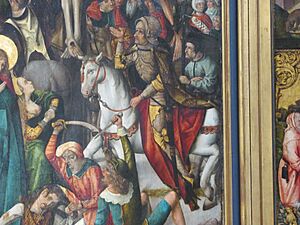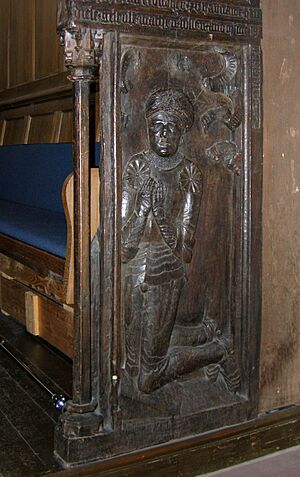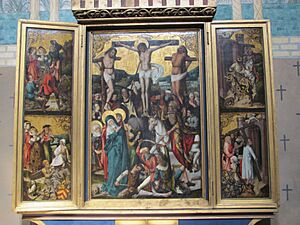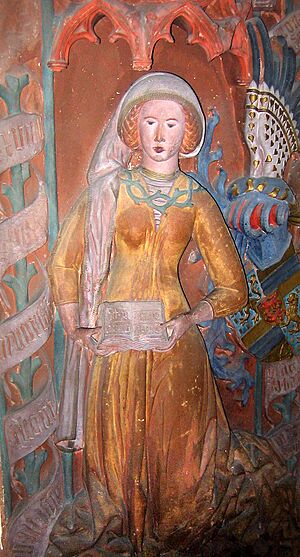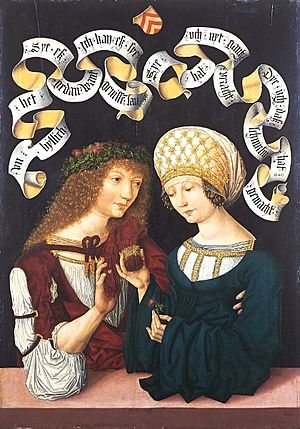Philipp I, Count of Hanau-Münzenberg facts for kids
Quick facts for kids Philipp I, Count of Hanau-Münzenberg |
|
|---|---|
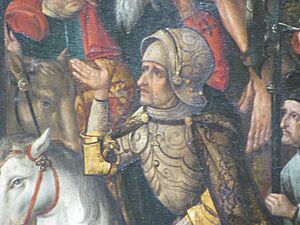 |
|
| Count Philipp I "the Younger" of Hanau, on the altar piece in Wörth am Main | |
| Spouse(s) | Adriana of Nassau-Siegen Margarete Weißkirchner |
| Noble family | House of Hanau |
| Father | Reinhard III, Count of Hanau |
| Mother | Countess Palatine Margaret of Mosbach |
| Born | 20 September 1449 Windecken, now part of Nidderau |
| Died | 26 August 1500 (aged 50) |
Count Philipp I of Hanau-Münzenberg, also known as Philipp the Younger, was born on September 20, 1449, at Windecken Castle. He passed away on August 26, 1500. Philipp was the son of Count Reinhard III of Hanau and Countess Palatine Margaret of Mosbach. He became the Count of Hanau in 1452. In 1458, the county was divided between him and his uncle, Philipp the Elder. Philipp the Younger then ruled the part called Hanau-Münzenberg until his death.
Contents
Early Life
Philipp I was born at Windecken Castle, which is now part of Nidderau. He was baptized in the local church. His godparents were important people of his time.
In 1452, when Philipp was only four years old, his father, Reinhard III, died. Because Philipp was so young, a group of guardians had to be set up to rule for him. From 1452 to 1458, his guardians included his grandfather, Count Palatine Otto I of Mosbach, his grandmother, Katharina of Nassau-Beilstein, and his uncle, Philipp the Elder. After 1458, Philipp the Elder became his only guardian until Philipp the Younger became an adult in 1467.
Dividing the County
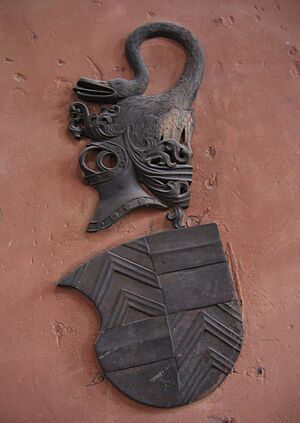
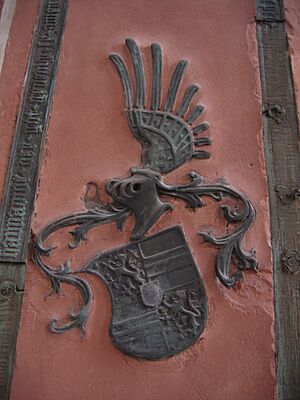
Why the County Was Divided
When Philipp the Younger became count, he was only four years old. This created a big problem for the Hanau family. For a long time, the family had followed a rule called primogeniture. This meant that only the oldest son would inherit everything. If they followed this rule, they hoped Philipp the Younger would grow up, marry, and have children to continue the family line. The good thing about this was that all the family's lands would stay together. The risk was that if Philipp the Younger died without a son, the family line might end.
The other option was to ignore the rule and let Philipp the Elder, his uncle, marry and have children. This would make it much more likely that the family line would continue. However, it meant the county would have to be split into two parts. This decision was urgent because Philipp the Elder was almost 40, which was considered old in the 1400s.
The Debate Over Division
The family and important people in the county debated this issue. Philipp the Younger's grandfather, Otto I, did not want the county to be divided. He wanted his grandson to inherit everything.
However, Philipp the Elder's supporters, including important cities like Hanau and Babenhausen, wrote letters asking that Philipp the Elder be allowed to marry. They believed this was the best way to ensure the family continued.
The 1458 Agreement
In 1457, Philipp the Younger's mother died. This made his grandfather, Otto I, less opposed to dividing the county. So, in January 1458, an agreement was made. Philipp the Elder received the part of the county south of the Main River. This included the district of Babenhausen. This way, the county was divided, but Philipp the Elder received a smaller portion. He was happy because he could finally marry. The rule of primogeniture would still apply to both new parts of the county.
This decision turned out to be a good one. Even though Philipp the Younger did have children, Philipp the Elder and his family were able to expand their lands a lot through marriages. Later, when Philipp the Younger's family line ended in 1642, the two parts of the county were reunited under Friedrich Casimir, who was a descendant of Philipp the Elder.
Naming the New Parts
To tell the two parts apart, the area ruled by Philipp the Elder was later called Hanau-Lichtenberg. This name came from Lichtenberg, which he inherited in 1480. Philipp the Younger's part was officially named Hanau-Münzenberg in 1496. Even before these official names, people often used Hanau-Lichtenberg and Hanau-Münzenberg to talk about the two parts.
Journeys to Jerusalem
In 1484, Philipp went on a special trip, called a pilgrimage, to Jerusalem. He sailed from Venice on June 10, 1484, and arrived in Jaffa on July 18. From there, he traveled to Jerusalem. He left Jerusalem on August 10, 1484, and visited Cyprus. He returned to Venice on November 30 and was back in Hanau by the end of January. He wrote about his journey, mostly listing the holy places he visited. He made a second trip to the Holy Land in 1491, traveling with Wilhelm I, Landgrave of Hesse.
His Time as Ruler
Expanding the Territory
During Philipp the Younger's rule, Hanau-Münzenberg gained more land. In 1470, they acquired Praunheim. In 1476, they got a share of the Ortenberg district. They also gained Fechenheim around 1473 or 1484, and Homburg in 1487. He also settled disputes with the City of Frankfurt and the Count of Isenburg. Philipp often had to deal with conflicts, but he always tried to solve them peacefully. A new imperial law in 1495, called the Ewiger Landfriede, which aimed to end private warfare, made his job much easier.
Imperial Connections
Philipp enjoyed traveling. He often visited royal courts in places like Heidelberg and Mainz. He went to Brabant in 1469 and attended a big meeting in Regensburg in 1471. In 1474, he joined Emperor Frederick III in Frankfurt and Linz. He also helped the Emperor in 1474 and 1475 by sending troops to help the city of Neuss when it was under attack. He visited the Emperor in Nuremberg in 1480 and the Duke of Lorraine in 1491. In 1494, he accompanied Maximilian I, who later became Emperor, to several cities.
Supporting Churches and Art
Philipp the Younger was a very religious person. He gave a lot of money to religious groups. He went on two pilgrimages to the Holy Land and collected holy items called relics. These trips deeply affected him.
He once tried to buy a whole collection of relics, including the head of St. Lawrence, from a monastery that needed money. However, the archbishop of Mainz didn't approve, so Philipp had to return them. As a trade-off, he received some villages from the monastery.
He also made many improvements to the St. Mary's church in Hanau:
- Starting in 1485, a beautiful Gothic choir was built.
- A chapel dedicated to St. Lawrence was decorated with paintings of saints.
- Some amazing artworks from his time are still around. One famous piece is a triptych (a three-part painting) now in the St. Nikolaus church in Wörth am Main. Philipp also ordered other altar pieces and paid for wood carvings on the choir stalls and stained glass windows.
Philipp also commissioned a famous painting called the Gotha Lovers. This painting likely shows him and his long-term partner, Margaret Weißkirchner. These artworks are very high quality and are some of the only medieval art pieces left from Hanau.
In 1468, Philipp's trumpeter, Erasmus Hasefus, started a small chapel in the Bulau Forest. This chapel, dedicated to St. Wolfgang, later grew into a small monastery.
Family Life
His Marriage
In 1460, Philipp the Younger was engaged to a daughter of Count Ludwig II of Isenburg-Büdingen. This engagement was later called off, and he paid a fee.
Philipp the Younger then married Countess Adriana of Nassau-Siegen on September 12, 1468. She was the daughter of Count John IV of Nassau-Siegen. They had six children:
- A daughter, born on April 4, 1469, who died soon after birth.
- Adriana (1470–1524), who married Count Philipp of Solms-Lich in 1490.
- Margaret (1471–1503), who became a nun.
- Reinhard IV (1473–1512), who later became Count of Hanau-Münzenberg.
- Anna (March 15, 1474 – March 21, 1475).
- Maria (March 4, 1475 – May 18, 1476).
His Other Relationship
After his wife Adriana passed away, Philipp the Younger lived with Margarete Weißkirchner. They could not marry because she was not from a noble family. However, their relationship was widely accepted, and they appeared in public together. The painting Gotha Lovers is a famous example of their relationship. They had children together:
- Elsa of Hanau, who married Heinrich Rabe around 1508.
- Johann of Hanau-Münzenberg, who became a priest.
- Anne of Hanau, who married Dietz Reuter in 1517.
These children could not inherit the county because their mother was not of high nobility. However, Philipp and Margareta mentioned them in their will. Their step-brother, Reinhard IV, made sure his step-sisters had good marriages and that his step-brother received a good church position.
Death
Philipp the Younger died on August 26, 1500. He was buried in the Church of St. Mary in Hanau. Many clergymen attended his funeral.
His Legacy
Historians today see Philipp's rule as a very positive time for his county and its people. The St. Mary's Church, the "Gotha Lovers" painting, and the "Wörth altar piece" are lasting examples of the great cultural achievements during his time. These artworks are still considered remarkable today. Philipp is now seen as one of the most important members of the House of Hanau.


